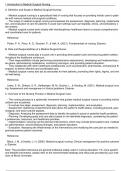I. Introduction to Medical Surgical Nursing
A. Definition and Scope of Medical Surgical Nursing:
- Medical surgical nursing is a specialized field of nursing that focuses on providing holistic care to patie
nts with various medical and surgical conditions.
- The scope of medical surgical nursing encompasses the assessment, diagnosis, planning, implementa
tion, and evaluation of care for patients in acute care settings such as hospitals, clinics, and ambulatory c
are centers.
- Medical surgical nurses work closely with interdisciplinary healthcare teams to ensure comprehensive
and coordinated care for patients.
Reference:
Potter, P. A., Perry, A. G., Stockert, P., & Hall, A. (2021). Fundamentals of nursing. Elsevier.
B. Role and Responsibilities of a Medical Surgical Nurse:
- Medical surgical nurses play a crucial role in providing direct patient care and ensuring patient safety t
hroughout the healthcare continuum.
- Their responsibilities include performing comprehensive assessments, developing and implementing c
are plans, administering medications, monitoring vital signs, and providing patient education.
- They collaborate with other healthcare professionals, such as physicians, pharmacists, and physical th
erapists, to deliver effective and coordinated care.
- Medical surgical nurses also act as advocates for their patients, promoting their rights, dignity, and ove
rall well-being.
Reference:
Lewis, S. M., Dirksen, S. R., Heitkemper, M. M., Bucher, L., & Harding, M. (2021). Medical-surgical nurs
ing: Assessment and management of clinical problems. Elsevier.
C. Overview of the Nursing Process in Medical Surgical Care:
- The nursing process is a systematic framework that guides medical surgical nurses in providing individ
ualized care to patients.
- It involves five steps: assessment, diagnosis, planning, implementation, and evaluation.
- Assessment: Gathering comprehensive data about the patient’s health status, including physical, psyc
hological, and socio-cultural aspects.
- Diagnosis: Analyzing the assessment data to identify the patient’s actual or potential health problems.
- Planning: Developing goals and care plans based on the identified diagnoses, considering the patient’
s preferences, resources, and healthcare priorities.
- Implementation: Carrying out the planned interventions, which may include direct patient care, medicat
ion administration, wound dressing changes, and patient education.
- Evaluation: Assessing the effectiveness of the interventions and modifying the care plan as needed to
promote positive patient outcomes.
Reference:
Black, J. M., & Hawks, J. H. (2020). Medical-surgical nursing: Clinical management for positive outcome
s. Elsevier.
Note: The provided references are general textbooks widely used in nursing education. For more specific
and detailed information, please refer to the recommended readings and resources provided by your instr
uctor at Brock University.
,II. Anatomy and Physiology Review
A. Review of Major Body Systems and Their Functions
1. Integumentary System
- Functions: Protection, regulation of body temperature, sensation
- Structures: Skin, hair, nails, sweat glands
- Alterations and Diseases: Dermatitis, skin infections, skin cancer
- Assessments and Interventions:
- Assess skin integrity, moisture, and temperature
- Promote hygiene and skin care
- Apply appropriate wound dressings
2. Cardiovascular System
- Functions:
Circulation of blood, transport of nutrients and oxygen
- Structures: Heart, blood vessels (arteries, veins, capillaries)
- Alterations and Diseases: Coronary artery disease, hypertension, heart failure
- Assessments and Interventions:
- Monitor vital signs, heart rhythm, and blood pressure
- Administer medications as prescribed (e.g., antihypertensives)
- Educate on lifestyle modifications (e.g., diet, exercise)
3. Respiratory System
- Functions: Gas exchange (oxygen and carbon dioxide), ventilation
- Structures: Lungs, trachea, bronchi
- Alterations and Diseases: Pneumonia, asthma, chronic obstructive pulmonary disease (COPD)
- Assessments and Interventions:
- Auscultate lung sounds and monitor oxygen saturation
- Administer bronchodilators or oxygen therapy as needed
- Educate on proper inhaler technique and smoking cessation
4. Gastrointestinal System
- Functions: Digestion, absorption of nutrients, elimination of waste
- Structures: Stomach, intestines, liver, pancreas
- Alterations and Diseases: Peptic ulcers, gastroenteritis, hepatitis
- Assessments and Interventions:
- Assess bowel sounds, abdominal pain, and nutritional status
- Administer medications (e.g., proton pump inhibitors) as prescribed
- Educate on dietary modifications and hygiene practices
5. Musculoskeletal System
- Functions: Support, movement, protection of organs
- Structures: Bones, muscles, joints
- Alterations and Diseases: Fractures, osteoarthritis, osteoporosis
- Assessments and Interventions:
- Assess mobility, strength, and range of motion
- Assist with ambulation and provide appropriate positioning
- Educate on fall prevention and exercises for strength and flexibility
, B. Common Alterations and Diseases Affecting Each System
1. Integumentary System
- Alterations: Dermatitis, eczema, pressure ulcers
- Diseases: Skin infections (e.g., cellulitis), skin cancer (e.g., melanoma)
2. Cardiovascular System
- Alterations:
Hypertension, coronary artery disease, arrhythmias
- Diseases: Myocardial infarction (heart attack), heart failure, peripheral artery disease
3. Respiratory System
- Alterations:
Pneumonia, bronchitis, respiratory distress
- Diseases: Asthma, chronic bronchitis, emphysema
4. Gastrointestinal System
- Alterations:
Gastroenteritis, constipation, gastroesophageal reflux disease (GERD)
- Diseases: Peptic ulcers, inflammatory bowel disease (e.g., Crohn’s disease, ulcerative colitis), liver dis
ease (e.g., hepatitis, cirrhosis)
5. Musculoskeletal System
- Alterations:
Fractures, sprains, strains
- Diseases: Osteoarthritis, rheumatoid arthritis, osteoporosis
C. Relevant Assessments and Interventions for Specific Conditions
1. Integumentary System
- Assessment:
Assess skin color, moisture, temperature, and integrity
- Interventions: Provide proper wound care, apply appropriate dressings, promote hygiene and skincare
2. Cardiovascular System
- Assessment:
Monitor blood pressure, heart rate, heart rhythm, and peripheral pulses
- Interventions: Administer medications as prescribed, monitor for signs of heart failure or complications,
educate on lifestyle modifications (e.g., diet, exercise)
3. Respiratory System
- Assessment: Auscultate lung sounds, monitor oxygen saturation levels
- Interventions: Administer bronchodilators or oxygen therapy as needed, promote proper inhaler techni
que, educate on smoking cessation and respiratory hygiene
4. Gastrointestinal System
- Assessment:
Assess bowel sounds, abdominal pain, nutritional status
- Interventions: Administer medications (e.g., antacids, laxatives), provide dietary modifications, educate
on proper hygiene practices and prevention of complications
5. Musculoskeletal System
- Assessment:
Evaluate mobility, range of motion, and strength




